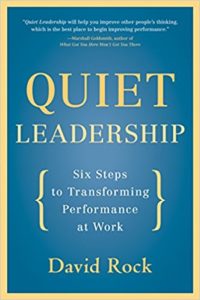
Thinking drives emotions that drives behaviors that then produce results. Managers spend their time trying to control results and to some extent behaviors. Leaders should apply their effort to impacting thinking, with a greater and longer-lasting effect on results. This is the big idea that David Rock sets forth in his book, “Quiet Leadership: Help People Think Better – Don’t Tell Them What to Do!”
The book begins with a short discussion of neuroscience and how the brain hardwires patterns of thinking. Yet the brain has a great deal of neuroplasticity, making it able to learn and adapt new ways of thinking. David Rock encourages leaders to understand and take advantage of this ability of the brain as they encourage the growth of the people that they lead. To do so, the author lays out a six-step process of transforming performance of the people that we lead.
Step 1 – Think About Thinking
This step goes back to the subtitle of the book. Rather than providing direction and instructions, leaders should guide and develop the thinking process of their people. We do this by asking thinking questions. Discussions should focus on solutions rather than problems and accentuate the positive. Conversations or meetings can easily get sidetracked. The author provides a tool that is termed “Choose Your Focus” to be used in guiding conversations, with five mental frames: vision, planning, detail, problem, and drama. He suggests that the parties in a conversation refer to these to be sure that all are on the same page.
Step 2 – Listen for Potential
David Rock suggests listening with the expectation that the person speaking can and will solve their own dilemmas. Listening for potential means using the advantage of an outside or distant perspective to help the speaker see their own insights, possibilities, and future.
Step 3 – Speak with Intent
The author suggests that quiet leaders are succinct, specific, and generous when speaking with others. They use few words to communicate the core of the idea that they desire to transmit. They speak so that the listener can clearly understand and relate. And the leaders objective is develop thinking.
Step 4 – Dance Toward Insight
Leaders are accustomed to giving advice and answers. It seems to be part of their DNA and they have been trained over years to do so. People come to them for answers. David Rock suggests a different response in this, what he calls the central thought of quiet leadership. It describes the conversation where the leader prompts the person toward finding the insight within themselves. This is done through a process consisting of seeking permission to dig into the dilemma, anchoring the conversation to define what is going to be accomplished, then questioning and clarifying in such a way as to help the other person clearly understand the dilemma. Of course, the questioning and clarifying process is delicate so that it draws out the other person rather than stifling them. See the book for details here.
Step 5 – Create New Thinking
Following on to the insight regarding the dilemma, the author describes a process for discovering a desired outcome through what he terms a CREATE model – Current Reality, Explore Alternatives, and Tap Energy. The concept is to guide the person through this model to build a thinking process and find their own best path to a solution.
Step 6 – Follow Up
Rock returns to neuroscience in this sixth step to emphasize that hardwiring the brain requires repeated and intentional practice. The follow up step reminds and embeds the thinking process. The author recommends his FEELING model to assure that the person has completely embraced the process. The FEELING model includes following up with a discussion that includes Facts, Emotions, Encouragement, Learning, Implications, and a New Goal.
This book is basically an instructional manual on how to coach people in developing their thinking capability. Since all leaders should be continually coaching their people, the book presents useful tools. These tools are not just for the workplace or for a leader working with subordinates. These tools can make the reader a more effective communicator and improve relationships of influence in any part of life. In this book David Rock encourages us to move away from giving quick answers towards building relationships of understanding and developing people.

Add your comment